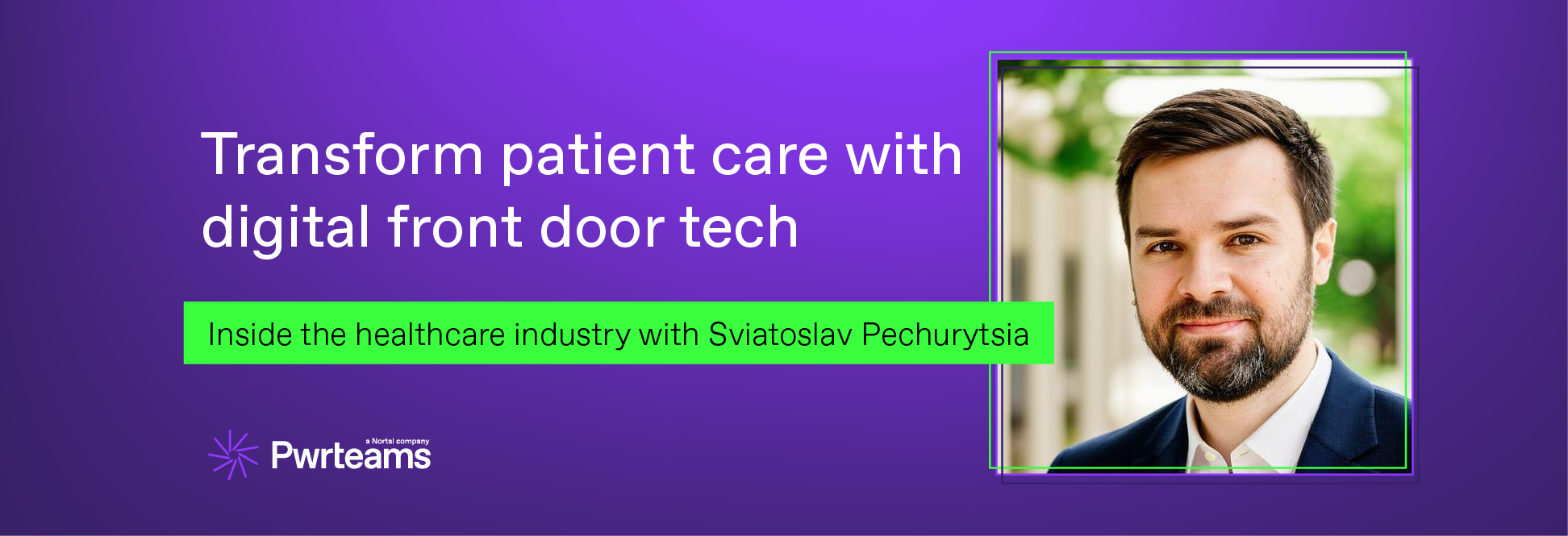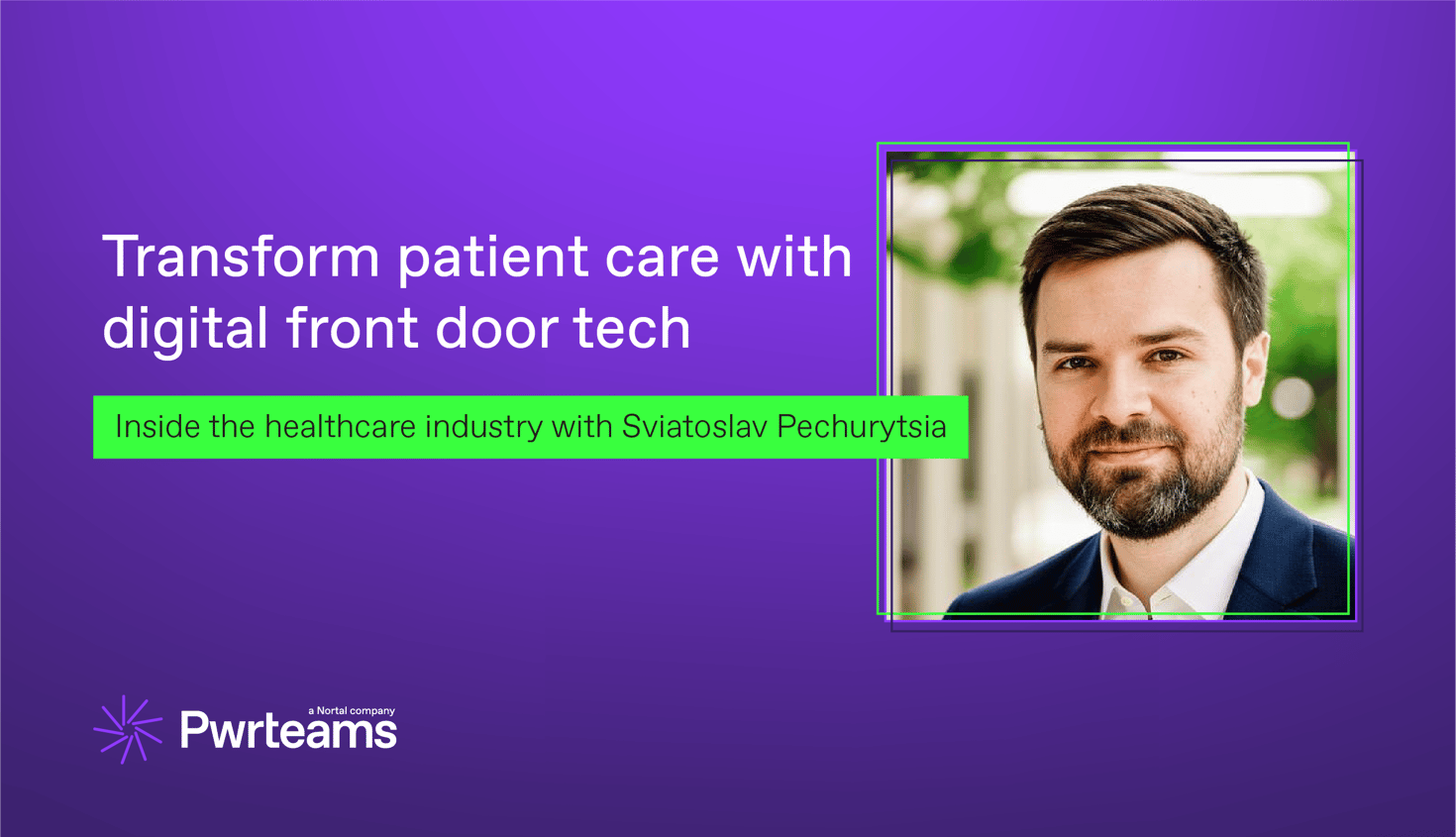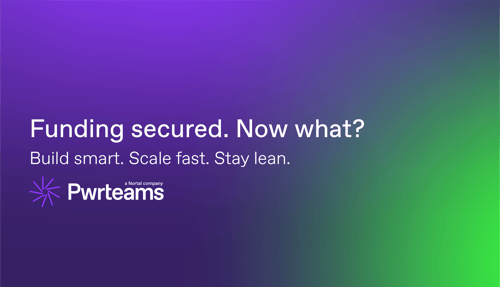Opening the digital front door to better patient experiences with team augmentation


It’s Monday morning, and Sarah wakes up to another throbbing pain. The headache won't let her get out of bed. This happens again, so instead of heading to work, she tries to book an appointment with a doctor. She gets stuck on hold for 20 minutes, only to find out that the earliest appointment is two weeks away. Frustrated, she heads online to search for another provider. If only her clinic had a digital front door in place...
Opening the Digital Front Door in healthcare
The digital front door brings healthcare straight to patients' homes and pockets effortlessly. It puts communication, documents, and services all in an online or mobile app. This way, patients can easily and immediately get the quality health service they need, while healthcare providers are less overwhelmed by simple inquiries and repeat tasks.
Because when you think of it, medical interventions are stressful and can be embarrassing. Long waits and misinformation only make them worse. To solve this, digital front door solutions offer exactly that – a front door for patients to access healthcare services easily and smoothly via digital channels.
After the global pandemic, digital services became one of the most important investment areas globally. By 2025, the digitisation of healthcare is projected to accelerate rapidly. In the UK, for example, hospitals aim to streamline care by providing virtual services to 50,000 patients per month.
If your healthcare business is catching up, here’s a quick look at the digital front door, what it offers, what it entails, and what skills you need to introduce it in your facility. And if you’re short on resources, dedicated teams can handle that for you – keep reading to find out how.
Instant self-service scheduling
One of the biggest patient frustrations is annoying appointment scheduling. 54% of Europeans struggle to even see their doctor. The wait times are long and access to medical professionals is limited. But with self-scheduling, patients can book, reschedule, and cancel appointments from any device, anytime.
No, imagine how different Sarah’s morning would be if she could schedule a visit with her doctor online instead of being stuck on the phone. She could just log into her mobile app with a fingerprint, choose a service or doctor, and pick up a date and time that best work for her.
Better still, the system would send her an appointment reminder via e-mail, calendar app, or text, reducing the risk of her non-attendance. This is huge for providers if you consider that no-shows cost the UK National Health Service over $1 billion and the US healthcare system $150 billion each year!
Convenient telehealth visits
During the pandemic, telehealth became a necessity. But even now, many patients still choose it as a primary way to get medical care. In 2024, over 116 million users are estimated to have accessed online doctor consultations, with projections reaching more than 130 million by 2028.
Virtual visits offer immense convenience, especially for elderly patients, people with disabilities, and those in rural areas. Study after study confirms this, showing a growing preference for online appointments. In Ireland, 32% of medical workers agree that telehealth reduced no-show rates compared to in-person consultations. Another 29% said that video consultations allowed them to increase the number of appointments available to patients.
Ignoring this trend and not tuning in would be carefree, but healthcare providers must also consider concerns voiced by doctors and other medical staff. For example, integrating telehealth visits with existing electronic health records and other key systems is a frequent complaint. Solving it requires the support of IT and tech professionals experienced in healthcare projects who know how to avoid common traps, what to pay attention to and which technologies to use to make you and your patients happy with end results.
Single-click self-check-in
Another solution that took off during the pandemic is self-check-in. It’s quick, safe, and simple and can be done from anywhere. Let’s say Sarah is running late for her doctor's appointment – hopefully, not the one she’s been waiting for for weeks. With a self-check-in kiosk at the clinic, she can register in seconds and get instant directions to the examination room without waiting in line at the front desk.
Text check-in is another popular solution. Even before Sarah arrives, she gets a personalised text with her appointment details. All she has to do is to reply and confirm, and she’ll presently get the room number and doctor's name without talking to anyone at the reception.
Not only is self-check-in convenient for patients, but when used strategically, it also has the potential to improve healthcare staff efficiency. These dual benefits make it a technology worth investing in.
Reliable online billing
Managing revenue cycles has always been a challenge for healthcare providers. Complex processes, dealing with multiple payers, and delays or denials in reimbursements can slow down collections, making it hard to keep a steady cash flow.
Online billing systems that connect with internal platforms can make payment collection and tracking financial data much easier for both patients and providers. When integrated with patient health records and mobile apps, they offer a seamless healthcare solution while enhancing collectability of dues.
And this is vital, as many patients in Europe rely on private practices for dental care and mental health. Public healthcare coverage for these services is limited especially for adults.
The perks of opening the Digital Front Door
The last thing you want for your patients is to have an experience like Sarah’s. Poor appointment scheduling, failing communication, and the absence of virtual visits can drive them away, harming your revenue and reputation.
Instead, opening the Digital Front Door is a great way to build a positive experience for patients even before they step into your facility. By offering tools like self-scheduling, secure messaging, payment management, and personalised educational resources, you can keep your patients engaged, informed, and in control.
This approach pays off in the long run, leading to greater patient engagement, improved health outcomes, and higher satisfaction. With 78% of digitally engaged patients more likely to stay loyal to providers they trust, the Digital Front Door can help you keep them by. However, to make it work, you’ll need to tackle some challenges.
Challenges of adopting the Digital Front Door
From our experience, one of the most common challenges when adopting Digital Front Door solutions is dealing with limited resources. Digital Front Door needs a significant investment in technology and staff training. Smaller practises, in particular, can find it tough to afford it, especially if they want to hire an in-house tech team to conduct the implementation.
Meanwhile, the existing team may often be insufficient, as such solutions demand specialist technical expertise. Successfully deploying and maintaining them involves a combination of software integration, research and development (R&D), cybersecurity, and data management skills. Without the right tech support, healthcare providers can experience glitches and delays. As a result, what was supposed to be a transformative solution can quickly turn into a hot and costly mess.
Then there’s the issue of integration. 67% of healthcare executives report that it takes over six months to identify, assess, and implement new solutions. That's a long time, especially since healthcare facilities often juggle multiple systems to manage patient data, scheduling, billing, and communications.
Making sure a Digital Front Door platform works seamlessly with existing systems is a vital task and not a small one. Poor integration can lead to inconsistent patient information and disrupted workflows. As a result, patient care takes a hit. To sidestep these issues, you need a team of dedicated professionals who can join you for a specific task or time to fine-tune and optimise your digital solution.
Instead of dealing with recruitment costs and pains, and having to sustain a tech team, you can confidently engage with an augmented team provider. They offer flexibility with no upfront fees, hidden costs, or long-term commitments, allowing you to try out their services risk-free, and scale up and down anytime. Learn what you can expect.
Unlock your Digital Front Door with augmented teams
A big shift is underway in healthcare. 40% of European healthcare executives rank patient engagement technologies within their top three most important areas of digital health investments within the next three years. The pressure to embrace technology in healthcare is stronger than ever. Hiring dedicated tech teams can offer a leg up in improving operational efficiency, boosting patient satisfaction, cutting costs, and reducing physician burnout. How? Here’s a quick rundown of what a team like ours can do for you.
Custom development of Digital Front Door platforms
Building a tailored Digital Front Door platform takes a team of experts working together to your current setup and specification for a familiar, seamless user experience.
Full-stack developers handle everything from designing intuitive user interfaces to ensuring the back-end runs smoothly. Alongside them, software architects develop the platform to be scalable and flexible and ensure it integrates easily with your existing healthcare systems. At the same time, UX/UI designers prioritise a user-friendly interface your patients are used to from other user-facing apps to remove friction from their path towards digital healthcare services.
Integration of digital services
Integrating digital services into your existing systems and workflows can get complex, but not for experienced tech teams who’ve worked on many similar projects.
Integration engineers make sure that technologies like telemedicine, self-scheduling, and billing systems blend smoothly into your current operations without disrupting day-to-day flow. First, they assess your existing stack to then tailor the integrated solution to be compatible. Meanwhile, API specialists create custom interfaces that allow your new platform to communicate clearly with other software and map data between the systems to avoid duplicates, missing information and errors.
Mobile apps development
With 313% more website traffic coming from mobile than desktop, offering a seamless app experience is non-negotiable.
Augmented teams specialising in mobile app development design and launch apps that let patients book doctor visits, refill prescriptions, and access health records from anywhere. For that, Android & iOS experts learn about your patients’ needs and the regulations your software must follow. Then, they choose the best tools and technology to meet those requirements, aiming to build a secure, fast, and intuitive app integrated with your healthcare platform ecosystem.
Next, quality assurance (QA) specialists rigorously test these apps; they test the app functionality, detect potential issues, measure the app’s performance and speed, check for vulnerabilities and potential data issues, verify regulatory compliance, and conduct other tests so the final product is reliable, secure, and easy to use.
Data security and consent management
Healthcare is one of the most vulnerable sectors to cyberattacks. That's why data security is a critical concern, especially with the rise of digital tools. Augmented teams bring the latest cybersecurity skills to the forefront, helping to protect patient data and maintain compliance with critical regulations like HIPAA or the General Data Protection Regulation (GDPR).
Cybersecurity specialists on your dedicated team also focus on encryption, secure data storage, and user authentication. At the same time, cloud security architects design cloud-based solutions that are resistant to cyber incidents and easily scalable when you need them. What’s important, they establish isolated development environments, working on their solutions without getting access to any of your patients' protected medical records.
Reinvent patient experience, digitally
Today, Sarah’s migraine unfortunately returned. But this time, she is just a few clicks away from getting urgent help. She opens the app, schedules a same-day virtual visit, and gets the assistance she needs without leaving her bed.
The app has her medical history and billing information on file, so after her consultation, she receives her prescription digitally and pays the bill with a quick tap. She sends the online prescription to a friend, who picks up the meds from the pharmacy and brings them over. Now, they can enjoy a peaceful afternoon together, Sarah free of pain.
A few key Digital Front Door solutions turned Sarah's frustration into a smooth, patient-first experience. Would you like to do the same for your patients?
Contact our dedicated tech specialists, build your expert team in a few weeks, and enjoy the benefits of Digital Front Door this year, still!
 August 5, 2025
August 5, 2025
Inside an Azure-based OWASP ZAP implementation
Read the post July 22, 2025
July 22, 2025
Scaling fintech in Benelux & Nordics – avoiding post-funding pitfalls
Read the post May 13, 2025
May 13, 2025
Close your round, scale your roadmap: how nearshore tech teams accelerate UK fintech growth
Read the postWrite your own
success story
with Pwrteams!
Share your details in the form, tell us about your needs, and we'll get back with the next steps.
- Build a stable team with a 95.7% retention rate.
- Boost project agility and scalability with quality intact.
- Forget lock-ins, exit fees, or volume commitments.